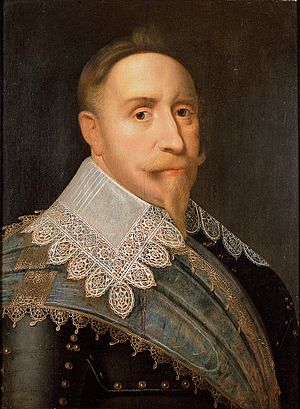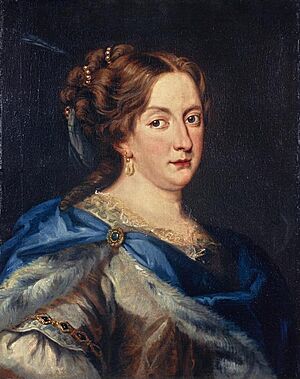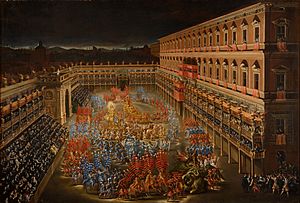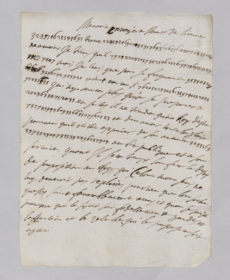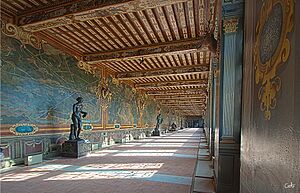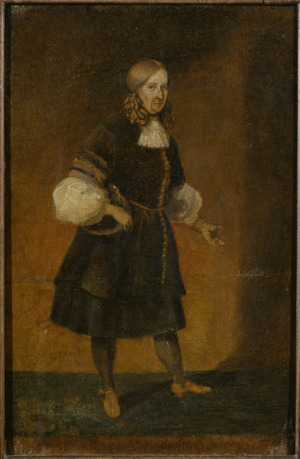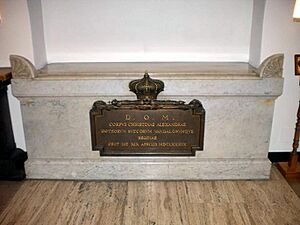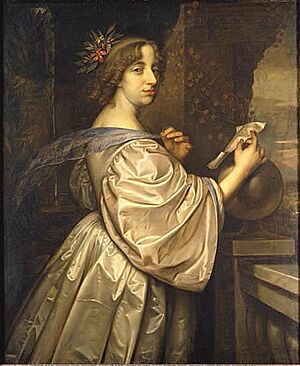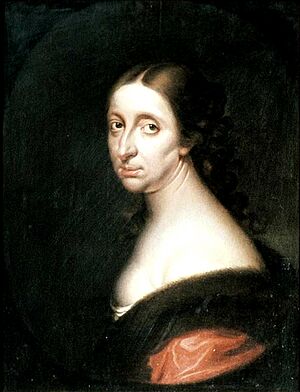Christina, Queen of Sweden facts for kids
Quick facts for kids Christina |
|||||
|---|---|---|---|---|---|
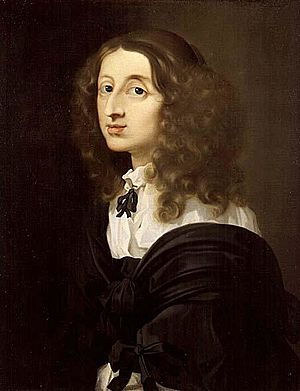
Portrait by Sébastien Bourdon, who
exaggerated her eyes. |
|||||
| Queen of Sweden | |||||
| Reign | 16 November [O.S. 6 November] 1632 – 16 June [O.S. 6 June] 1654 |
||||
| Coronation | 20 October 1650 | ||||
| Predecessor | Gustav II Adolf | ||||
| Successor | Charles X Gustav | ||||
| Regent | Axel Oxenstierna (1632–1644) | ||||
| Born | 18 December [O.S. 8 December] 1626 Tre Kronor Castle, Stockholm |
||||
| Died | 19 April 1689 (aged 62) Rome, Papal States |
||||
| Burial | 22 June 1689 St. Peter's Basilica, Vatican City |
||||
|
|||||
| House | Vasa | ||||
| Father | Gustav II Adolf of Sweden | ||||
| Mother | Maria Eleonora of Brandenburg | ||||
| Religion | Lutheran (1626–1654) Catholic (1654–1689) |
||||
| Signature | |||||
Christina (Swedish: Kristina, 18 December (New Style) 1626 – 19 April 1689) was the Queen of Sweden from 1632 until she gave up her throne in 1654. She was part of the House of Vasa, a famous royal family. Christina became queen when her father, Gustavus Adolphus, died in battle in 1632. She officially started ruling the Swedish Empire when she turned 18 in 1644.
Queen Christina was known as one of the smartest women of her time in the 1600s. She loved books, old writings, paintings, and sculptures. She was very interested in religion, philosophy, math, and even alchemy (an old form of chemistry). Because of her interests, many scientists and thinkers came to Stockholm, as she wanted the city to be known as the "Athens of the North."
Christina played a big part in ending the Thirty Years' War. However, her spending habits caused financial problems for Sweden. She also surprised many people when she decided not to marry. Later, she secretly became a Catholic in Brussels and then announced it publicly in Innsbruck. After this, she gave up her throne to her cousin and moved to Rome.
Pope Alexander VII once described Christina in a very strong way, but she was also a major supporter of theater and music. She helped many Baroque artists, composers, and musicians. Christina was a guest of five popes and was a symbol of the Counter-Reformation, which was the Catholic Church's response to the Protestant Reformation. She is one of the few women buried in the Vatican grotto.
Contents
- Early Life of Queen Christina
- Regency and Early Education
- Christina's Reign as Queen
- Abdication of the Throne
- Life in Exile
- Travels to France and Italy
- Return to Rome
- Later Life and Interests
- Death and Burial
- Queen Christina as an Art Collector
- Appearance and Style
- Christina's Legacy
- Family tree
- See also
Early Life of Queen Christina
Christina was born in the royal Tre Kronor Castle in Stockholm on December 18, 1626. Her parents were King Gustavus Adolphus of Sweden and his wife, Maria Eleonora of Brandenburg. Her parents had hoped for a boy, but when Christina was born, her father was very happy, saying, "She'll be clever, she has made fools of us all!"
Her mother, Maria Eleonora, was disappointed that Christina was a girl and didn't show much affection. The king was worried about his wife's emotional state and made sure she didn't have much say in Christina's upbringing.
The Swedish crown was passed down through the House of Vasa. Christina became the clear heir to the throne because her father had no other living children. Even though she was a girl, King Gustav Adolph recognized her right to rule. When she was crowned in 1633, her official title was "king."
Regency and Early Education
In June 1630, when Christina was just three years old, her father, King Gustav Adolf, left for Germany to fight in the Thirty Years' War. He made sure that if he didn't return, Christina would inherit the throne. He also gave instructions that Christina should be educated like a boy, which was unusual for girls at that time.
Sadly, King Gustav Adolf died in battle on November 6, 1632. Christina's mother, Maria Eleonora, returned to Sweden with his body. She was very sad and didn't want the burial to happen. However, Axel Oxenstierna, a powerful Swedish statesman, arranged for the king to be buried in 1634.
After her father's death, Christina's mother became very focused on her, but in a difficult way. The king had planned for his half-sister, Catherine, to care for Christina. But Maria Eleonora didn't like this and kept Catherine away from the castle. In 1634, a new constitution was introduced, which stated that the "King" (Christina) must have a Privy Council, led by Oxenstierna.
Because Maria Eleonora was considered difficult, she lost her parental rights in 1636. The council believed she was not good for Christina's upbringing. Maria Eleonora was sent away to Gripsholm Castle, and Christina was cared for by her aunt Catherine. Christina was much happier during this time.
After her aunt Catherine died in 1638, the Royal Regency Council decided to appoint several women to look after Christina. This was to make sure Christina didn't become too attached to just one person. These women were Ebba Leijonhufvud, Christina Natt och Dag, Beata Oxenstierna, and Ebba Ryning. Christina, however, didn't seem to form strong bonds with most of her female courtiers. She often felt more comfortable with masculine activities and interests.
Christina received an education usually given to royal boys. Her tutor, Johannes Matthiae Gothus, taught her religion, philosophy, Greek, and Latin. Chancellor Oxenstierna taught her about politics. Christina loved to study, sometimes for ten hours a day. Besides Swedish and German, she learned at least six more languages, including Dutch, Danish, French, Italian, Arabic, and Hebrew. People were amazed at how well she spoke French, saying she spoke it "as if she was born in the Louvre!"
Christina's Reign as Queen
In 1644, Christina was declared an adult and ready to rule, though her coronation was delayed due to a war. She soon showed that her political ideas were different from those of Chancellor Oxenstierna. Christina strongly wanted peace to end the Thirty Years' War, even when Oxenstierna did not.
The Peace of Westphalia was signed in 1648, which finally ended the long European wars. Sweden gained a lot from this peace, including money and new territories. This made Sweden a very powerful country, controlling much of the Baltic Sea.
Christina also brought new people into her council, even those who were not from noble families, to balance the power of the aristocracy. In 1649, she declared her cousin, Charles Gustav, as her heir, which was a way to reduce Oxenstierna's influence.
Supporting Arts and Learning

Christina was a great supporter of the arts and learning. In 1645, she founded Ordinari Post Tijdender, which is the oldest continuously published newspaper in the world. After the Battle of Prague (1648), many valuable treasures, including books, manuscripts, and art, were brought to Stockholm for her collection. She acquired famous works like the Codex Argenteus and the Codex Gigas.
She wanted to gather smart people around her, as well as books. She invited many famous scholars to visit her in Sweden, including the philosopher René Descartes. Christina was very interested in different ideas and studied many subjects, from ancient history to different religions.
Christina loved theatre and was even an amateur actress herself. She invited French and Italian theater groups to perform in Sweden. She also supported Swedish playwrights and musicians.
Meeting René Descartes
In 1646, Christina became interested in the philosopher René Descartes through her friend, the French ambassador. She invited Descartes to Sweden to help her set up a scientific academy. Descartes arrived in October 1649. Christina had a very strict schedule, and she would invite him to the cold castle at 5:00 AM every day to talk about philosophy. They didn't always agree, and Descartes found her schedule difficult. He caught a cold and sadly died in February 1650.
Coronation and Personal Life
Christina's coronation took place on October 22, 1650. It was a grand event with a long procession and celebrations that lasted for days. Fountains flowed with wine, and there were parades and feasts.
From a young age, Christina was interested in the idea of not marrying. She read about Queen Elizabeth I of England, who also never married. Christina felt she had "an insurmountable distaste for marriage" and preferred her studies. She often worked very hard, sleeping only a few hours a night. She was known for her simple clothes and sometimes wore men's shoes for comfort. She also wrote very emotional letters to her close friend, Ebba Sparre, showing deep affection.
Religion and Health
Christina was raised in the Lutheran Church of Sweden. Her tutor, Johannes Matthiae, had more gentle religious views than many Lutherans. Christina supported him when he tried to introduce new church rules, even against the advice of Chancellor Oxenstierna.
In 1651, after many years of working very hard, Christina became very ill. She had high blood pressure and other health issues. A French doctor named Pierre Bourdelot came to Stockholm in 1652. Unlike other doctors, he told her to get more sleep, take warm baths, and eat healthy food, instead of her usual strict lifestyle. He encouraged her to relax and enjoy life more, and to stop studying so intensely.
Christina also had long talks with Antonio Macedo, a Jesuit priest, about different religious ideas. She became very interested in Catholic views. Around May 1652, Christina decided to become Catholic, even though she had been raised Lutheran. She kept this decision secret for a while.
Abdication of the Throne
On February 26, 1649, Christina announced that she would not marry and wanted her cousin, Charles Gustav, to be her heir. The nobility didn't like this, but the other groups in society accepted it. She agreed to stay queen only if they never asked her to marry again.
Christina's popularity decreased after some controversial events. In 1653, she founded a special order called the Amaranten order, whose members promised not to marry. She also started sending many of her valuable books and manuscripts to Antwerp.
In February 1654, she told her council that she planned to give up the throne. Oxenstierna warned her she would regret it. In May, the Swedish parliament discussed her plans. She asked for a large annual payment and received land and income from several towns and islands. This secured her financially.
Her decision to give up the throne was not just about her conversion to Catholicism. There was also growing unhappiness with her spending and how she gave away many noble titles and lands. This caused financial strain on the country.
Christina officially gave up her throne on June 6, 1654, in favor of Charles Gustav. During the ceremony, her royal symbols were removed one by one. She even had to take off her own crown because no one else would. Dressed in a simple white dress, she gave a farewell speech and left the throne to Charles X Gustav. She left Sweden a few days later.
Life in Exile
In the summer of 1654, Christina left Sweden dressed in men's clothes and traveled through Denmark as "Count Dohna." This was because relations between Sweden and Denmark were still tense, and it wasn't safe for a former Swedish queen to travel openly. She had already sent many of her valuable books, paintings, and other treasures out of Sweden.
Christina visited different places in the Netherlands and then settled in Antwerp. She was visited by many important people and held parties, but she quickly ran out of money. She had to sell some of her belongings. She then moved to Brussels. On December 24, 1654, she secretly converted to the Catholic faith. She didn't announce it publicly yet, in case Sweden would stop paying her.
In September, she traveled to Italy with a large group of people and horses. On November 3, 1655, in Innsbruck, she publicly announced her conversion to Catholicism. To celebrate, an opera was performed. Her journey to Rome was a grand event, planned by the Vatican.
Settling in Rome
Christina arrived in Rome on December 20, 1655, in a special carriage designed by the famous artist Bernini. She met Bernini the next day, and they became lifelong friends. She was given her own section inside the Vatican, decorated by Bernini.
Her visit to Rome was a big triumph for Pope Alexander VII. For months, she was the center of attention, with nobles holding fireworks, jousts, and operas in her honor. She settled in the Palazzo Farnese, a grand palace. Every Wednesday, she opened her palace to visitors for poetry and intellectual discussions. In 1656, she opened an academy called Academy of Arcadia, where people enjoyed music, theater, and literature.
Christina, who was 29, caused some talk because she socialized freely with men her age. One of them was Cardinal Decio Azzolino. They were very close friends for the rest of their lives. Meanwhile, Christina learned that Sweden had stopped her payments because she had become Catholic.
Travels to France and Italy
Christina wanted to become a mediator between France and Spain. Her plan was to lead French troops to take Naples and rule there, eventually giving the crown to France. In July 1656, she sailed to Marseille and then traveled to Paris.
In Paris, she was treated with respect by the young King Louis XIV and his mother. They made an agreement that Louis XIV would support her as queen of Naples. This would make her financially independent from Sweden.
On her way back, Christina visited different cities. During the winter, she lived in Pesaro, possibly to avoid the plague that was affecting Naples. In July 1657, she returned to France.
The Monaldeschi Incident
In October 1657, while staying at the Palace of Fontainebleau, Christina was involved in a serious event. She suspected her master of the horse, Gian Rinaldo Monaldeschi, of being disloyal. She secretly found letters that showed he had betrayed her. Christina believed he deserved to be punished. After a discussion, he was killed by her servants.
Christina stated that she was responsible for the act and that justice had been carried out. While some people in Rome were upset because Monaldeschi was an Italian nobleman, Christina believed she had the right to judge members of her own court. She continued to see herself as a ruling queen throughout her life.
Return to Rome
Christina returned to Rome for the second time in May 1658. This time, her popularity was lower due to the Monaldeschi incident. Pope Alexander VII was less welcoming. Christina began to write her autobiography. In July 1659, she moved to Palazzo Riario, which became her home for the rest of her life. Cardinal Azzolino helped her with the move and hired new servants.
She decorated her new palace with many beautiful paintings, especially from the Venetian and Renaissance periods. Her art collection was one of the best in Rome. She owned famous paintings by artists like Correggio and Titian.
Later Life and Interests
In April 1660, Christina learned that her cousin, Charles X Gustav, had died. His son, Charles XI, was only five years old. Christina went back to Sweden, suggesting that if Charles XI died, she would take the throne again. However, because she was Catholic, this was not possible. She eventually gave up her claim to the throne again and spent a year in Hamburg to sort out her finances before returning to Rome.
Christina returned to Rome for the third time in 1662. These were generally happy years. In 1666, she tried to return to Sweden again but was only allowed to settle in Swedish Pomerania. She decided to go back to Hamburg. There, she learned that Pope Alexander VII had died. The new pope, Clement IX, had been a frequent guest at her palace, and she was delighted by his election. She threw a big party in Hamburg, which angered the local Lutheran people and led to some trouble.
In 1668, John II Casimir gave up the Polish throne. Christina, as a member of the House of Vasa, put herself forward as a candidate for the Polish throne. She had the support of Pope Clement IX, but she was not chosen. She seemed happy about this, as it meant she could return to her beloved Azzolino.
Christina's fourth and final return to Rome was on November 22, 1668. Pope Clement IX often visited her, as they both enjoyed plays. Christina opened Rome's first public theater in a former jail in 1671.
Later, a new pope, Innocent XI, became concerned about theater and public morals. He even turned Christina's theater into a storeroom and forbade women from performing. Christina disagreed and allowed women to perform in her palace. She continued to support musicians and poets, and many famous composers dedicated their works to her.
Christina was very tolerant of other people's beliefs throughout her life. She even spoke out against the persecution of French Protestants and issued a declaration that Roman Jews were under her protection.
Death and Burial
In February 1689, Christina, at 62 years old, became very ill. She suffered from diabetes mellitus. She seemed to get better, but in April, she developed a serious infection and a high fever. She died on April 19, 1689, in her palace in Rome.
Christina had asked for a simple burial, but the pope insisted on a grand display. Her body was shown for four days in her palace, embalmed and dressed in royal robes. Like popes, her body was placed in three coffins. Her funeral procession on May 2 led to St. Peter's Basilica, where she was buried in the Vatican grotto. She is one of only three women to be given this honor.
In 1702, Pope Clement XI ordered a monument to be built for Christina in the basilica, recognizing her conversion and her contributions to the culture of Rome. Christina had named Cardinal Azzolino as her heir, but he also died shortly after her. His nephew then sold Christina's large art collection.
Queen Christina as an Art Collector
Before 1649, Sweden's royal art collection was not very impressive. However, in May 1649, a huge collection of art arrived from Prague Castle, which had been taken by Swedish armies during the war. This collection had belonged to Rudolf II, Holy Roman Emperor, and was one of the most important in Europe.
Christina was fascinated by these new treasures and continued to collect art for the rest of her life. She was one of the greatest female art collectors of her time. She especially loved Italian paintings.
When she left Sweden, Christina took about 70 to 80 paintings with her, mostly portraits of friends and family, and some Italian works from the Prague collection. She also took statues, jewels, and tapestries. She had sent these valuable items to Antwerp almost a year before she gave up her throne, showing she had planned her departure.
Christina greatly expanded her collection while living in Rome. She acquired famous works by artists like Raphael and Titian. She received many gifts from Catholic royalty after her conversion. She also gave some generous gifts herself, such as Albrecht Dürer's famous paintings of Adam and Eve to the King of Spain.
Her palace in Rome, the Riario Palace, was a perfect setting for her collection. It had a special "Paintings Room" with many masterpieces by Titian, Veronese, Raphael, and Correggio.
Christina liked to have portraits painted of herself and her friends. She encouraged artists to study her collection. When she died, her collection went to Cardinal Decio Azzolino, and then to his nephew, who sold it. Many of her paintings ended up in France, forming the core of the Orleans Collection, and some are now in the National Gallery. Her large library was bought by the Vatican Library. Her sculpture collection was sold to the King of Spain. Many of her drawings are now in the Teylers Museum in the Netherlands.
It's interesting to note that if her collections had stayed in Sweden, they would have been destroyed when Stockholm Castle burned down in 1697. So, by taking them with her, Christina actually saved many valuable artworks.
Appearance and Style
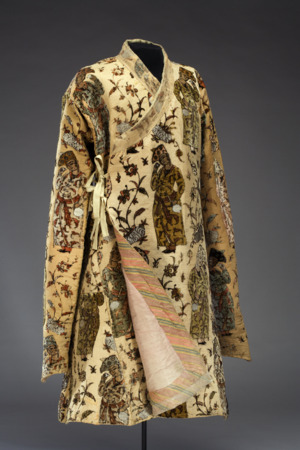
People often talked about Christina's physical features and how she dressed. She was known to have a slightly bent back and uneven shoulders, possibly from an injury when she was a baby.
When she was born, the midwives first thought she was a boy because she was "completely hairy and had a coarse and strong voice." As a child, Christina was a bit of a tomboy. Her father wanted her to have "the education of a prince," and she enjoyed activities like fencing, horse riding, and bear hunting more than typical feminine hobbies.
As an adult, people said Christina "walked like a man, sat and rode like a man, and could eat and swear like the roughest soldiers." When she arrived in Rome, she had shaved her head and wore a large, dark wig. Later, she often wore men's velvet coats, ties, and wigs. She also used a lot of powder and face cream. Some described her as looking "like a sort of Egyptian street girl, very strange, and more alarming than attractive."
Christina's Legacy
Christina's unique personality and life story have inspired many plays, books, and operas. Some notable works include:
- The opera Cristina, regina di Svezia (1849) by Jacopo Foroni.
- August Strindberg's play Kristina (1901).
- The classic film Queen Christina (1933), starring Greta Garbo, which tells a fictionalized version of her life.
- The film The Abdication (1974), starring Liv Ullmann, based on a play.
- The play Christina, The Girl King (2012) by Michel Marc Bouchard.
- The 2015 film The Girl King, based on the play.
- She is featured as the leader of Sweden in the video game Civilization VI: Gathering Storm, known for her focus on culture and art.
Christina's name also lives on in places. In 1638, Fort Christina was built in what is now Wilmington, Delaware, named after her. The Christina River and the Queen Village neighborhood in Philadelphia are also named in her honor. Other places include Kristiine District in Tallinn, Estonia, and Kristinestad, Finland.
Family tree
| Charles IX | |||||||||||||||||||||||||||||||||||||||||||||||||||||||||||
| Maria Eleonora | Gustavus Adolphus | Catherine | John Casimir | Carl Gyllenhielm | |||||||||||||||||||||||||||||||||||||||||||||||||||||||
| Christina | Charles X Gustav | ||||||||||||||||||||||||||||||||||||||||||||||||||||||||||
See also
 In Spanish: Cristina de Suecia para niños
In Spanish: Cristina de Suecia para niños



